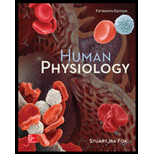
Concept explainers
Describe the actions of muscles when they contract, and define the terms agonist and antagonist in muscle action.
To review:
The actions of contracted muscles and the definitions of antagonist and agonist involved in muscle action.
Introduction:
The skeletal muscles are composed of muscle fibers and activated by somatic motor neuron that results in the contraction of these muscles leading to their movement. The skeletal muscles are joined to the bones at both ends through tendons (connective tissue). The contraction and relaxation result in different movements of the body.
Explanation of Solution
The skeletal muscle contraction results in various actions or movements that depend upon the type of joints and attachments present within the muscles. Different actions that are seen during the contraction of different muscles are given below:
Agonist- Agonist provides the major force to complete the movement. They are also known as ‘prime movers’of skeletal muscles and cause movement through their own activation.
Antagonist- In antagonist muscles, the contraction is done by the involvement of two muscles such as flexor and extensor whict act on the same muscle (as agonist) causing the opposite action.
Want to see more full solutions like this?
Chapter 12 Solutions
Human Physiology
- In a small summary write down:arrow_forwardNot part of a graded assignment, from a past midtermarrow_forwardNoggin mutation: The mouse, one of the phenotypic consequences of Noggin mutationis mispatterning of the spinal cord, in the posterior region of the mouse embryo, suchthat in the hindlimb region the more ventral fates are lost, and the dorsal Pax3 domain isexpanded. (this experiment is not in the lectures).a. Hypothesis for why: What would be your hypothesis for why the ventral fatesare lost and dorsal fates expanded? Include in your answer the words notochord,BMP, SHH and either (or both of) surface ectoderm or lateral plate mesodermarrow_forward
 Human Physiology: From Cells to Systems (MindTap ...BiologyISBN:9781285866932Author:Lauralee SherwoodPublisher:Cengage Learning
Human Physiology: From Cells to Systems (MindTap ...BiologyISBN:9781285866932Author:Lauralee SherwoodPublisher:Cengage Learning Human Biology (MindTap Course List)BiologyISBN:9781305112100Author:Cecie Starr, Beverly McMillanPublisher:Cengage LearningLifetime Physical Fitness & WellnessHealth & NutritionISBN:9781337677509Author:HOEGERPublisher:Cengage
Human Biology (MindTap Course List)BiologyISBN:9781305112100Author:Cecie Starr, Beverly McMillanPublisher:Cengage LearningLifetime Physical Fitness & WellnessHealth & NutritionISBN:9781337677509Author:HOEGERPublisher:Cengage





